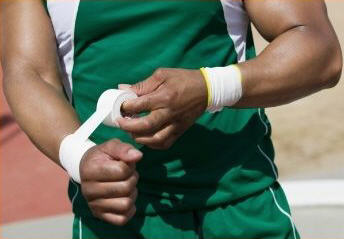The first time I saw grip spray used in rugby was during the 2009 British and Irish Lions tour in South Africa.
The Lions were playing an invitational team, the Royal XVs. A young Irish winger kept dropping the ball, and a physio came onto the pitch and vigorously sprayed his palms.
It’s fairly common now to see spray applied to players’ hands before and during a match. What are they putting on their hands? There are a few possibilities.
What Do Rugby Players Spray On Their Hands?
The spray is going to be one of these options:
- Cooling spray for pain relief
- Adhesive spray before tape is applied
- Grip spray
Cooling spray
You may see physios on the pitch applying cooling spray to players’ hands (or legs). This is a spray for temporary pain relief.
If a player gets a hand stepped on, fingers bent, or any number of other hand injuries, they might be given this spray to give their hands enough pain relief to allow them to continue playing.
This probably wouldn’t be a great option for anyone who might be doing a lot of ball handling though. Cooling spray can also lower the dexterity of the hand.
Adhesive spray for tape

Another possibility is that the player or physio might be applying an adhesive taping base spray. This is sprayed on before athletic tape is applied.
The adhesive spray improves the holding time for the tape and keeps it from slipping.
Adhesive spray can even be used to hold things like a knee or thigh brace in place.
You will know that this is what is being applied if the hand that is sprayed is taped immediately after the spraying.
Grip spray
The final possibility is that the player is applying grip spray to give themselves an advantage when handling the ball.
The giveaway here is when players are rubbing their hands together and intertwining their fingers. This is to make sure that the hands have complete and even coverage of the spray.
The rest of this article is on grip spray.
Different Types Of Hand Grip Spray in Rugby

Unlike some other sports (that we’ll mention later), grip spray is completely legal in rugby.
There are two types of grip spray in common use:
- Sticky spray
- Drying spray
Sticky spray
The first type is a spray designed to make hands tacky so that the ball will stick to the player’s grip.
An example of this is Mueller Stickum Grip Spray. I checked the ingredients and the key item is “resin”. This resin is a glue-like material that gives stickiness to the hands.
In the United Kingdom? You may find this brand easier to get from Amazon (don’t worry that it says its for basketball, it works great for rugby).
This will work if the player’s hands are dry, and even if they are wet.
When players feel that the tackiness is wearing off, they can simply get it wet to reactivate the stickiness. Some players will spit on their hands for this effect. But you can also grab a water bottle to sprinkle on your palms.
But there can be an opposite problem of the stickiness wearing off. I’ve heard tales of players applying far too much spray on their hands.
They have to resort to kicking the ball out of their palms to get rid of it. I wish I’d seen this in action, it sounds hilarious. However, it doesn’t happen very often – so players must get used to what is too much!
Another potential drawback is that some players feel that the tackiness changes the release of the ball. They don’t like sticky spray because it affects the accuracy of their pass.
Drying spray
Drying spray provides an alternative.
This type of spray is known as being “hydrophobic”. This means that it repels water. It dries sweaty palms and works well in wet weather and hot humid conditions.
The sprays also disperse fine grit particles across the surface area of your hands. These grit particles are activated by moisture and give some degree of friction and tackiness.
However, it doesn’t give the same “sticky” feel as the likes of Mueller Stickum.
An example of this second type of grip spray is GripTec Grip Spray.
How Does Grip Spray Help Rugby Players?
Improved grip can help a rugby player in all kinds of ways. Let’s take a look at a few examples.
Reduce fumbles
The first and foremost way is to prevent a player from fumbling the ball.
Fumbling is probably the most common mistake in rugby. And it has a costly impact on the player’s team as it results in a scrum to the opposition.
A simple spray that helps prevent this is an obvious aid to a player’s game.
Accurate passing
It’s also an aid to giving and receiving passes at speed. This makes grip spray quite popular with the backline, who tend to be taking a pass as they run onto the ball with pace.
Backs, who do most of the passing, may use a drying spray on a hot, humid day and a tacky spray on a wet day to help with their grip when passing.
Better catching
Wingers and fullbacks may also spray the fronts of their shirts. This is to help them catch a high dropping ball.
It gives a little extra help when they’re grasping the ball as it drops into the breadbasket (their chest).
But grip spray is not solely the province of the backs. Forwards use grip spray too!
Lineout throws

On a rainy day, you’ll see hookers on the sideline carefully drying the ball with a towel. This, of course, is to aid their grip as they throw the ball into the lineout.
It’s not unknown for ballboys from the opposition team “drying” the ball with a wet towel.
Hookers also use grip spray to help with throwing the ball in rainy or muddy conditions.
Psychological help
Finally, grip spray may help with one of the players’ most important attributes: confidence.
At the beginning of a match, a player’s nerves are at their worst. This can cause mistakes or tentative play.
Even if the spray doesn’t last through the whole match, just having it at the beginning can boost the player’s confidence. Hopefully, this makes mistakes less likely, including fumbling and knocking on.
Grip Sprays in Other Sports
Grip sprays aren’t only used in rugby. They are used in many sports where grip is important. Here are a few examples:
- Weightlifters use spray to help grip the bar.
- Gymnasts use spray to help grip rings, bars, or any other kind of equipment.
- Golfers use it for grip on their clubs.
- Motorcycle racers sometimes put grip spray on their hands before putting on their gloves to prevent the gloves from sliding during a race.
In other sports, grip sprays may or may not be legal. The NFL is a prime example.
Illegal sprays in the NFL

Before 1981, Stickum was in common use by backs and receivers in the NFL to help them catch and hold the ball.
This was before Lester Hayes. Lester Hayes was a defensive back for the Oakland Raiders who used so much stickum that he ruined it for everyone else.
Anyone who watched the NFL at that time still remembers the images of Hayes with long tendrils of stickum literally dripping from his hands and forearms and chunks of turf glued all over his uniform.
As a result of this, stickum was banned in 1981, in what is still known as the “Lester Hayes Rule”.
NBA has more lenience

The NBA allows drying spray, but not anything sticky.
Therefore, theoretically, stickum is not allowed, but this rule is rarely enforced.
In 2016, NBA star Dwight Howard was briefly involved in a controversy when he admitted to using stickum in a game.
The reason it became an issue in this particular game was that Howard used so much spray that it actually made the other players complain about how odd the ball felt in their hands.
However, Howard was not disciplined in any way for this. The NBA just sent a letter to all teams reminding them that any kind of sticky hand spray was illegal.
Howard said that he had been using it for years and so do a lot of other players. NBA players commonly use the pre-tape adhesive spray on their hands as a way to get around the Stickum ban.
Modern Alternatives
There are other alternatives to spray, often provided by the same companies.
You can also get waxes in tubs that are marketed for handball or basketball. Many of the online reviews are by pole dancers!
This will give you a hint that the waxes may be too adhesive for rugby. You need to catch the ball, but you also need to pass it.
Older Alternatives
What did players do before things like sticky spray were invented? After all, rugby has been played in wet and muddy conditions since its early days in England schools in the 1820s.
There’s a simple answer: spit! And you may still see scrum-halves and hookers spitting on their hands before a scrum or a lineout.
They’d best not overdo it or referees will have a word. It’s hardly the most hygienic practice for the rest of the players!